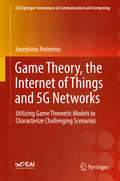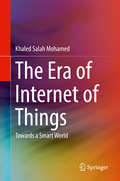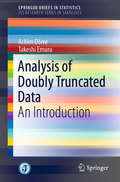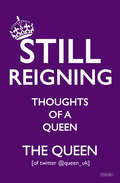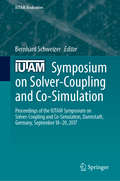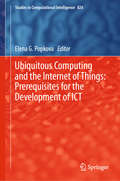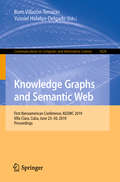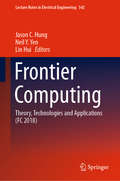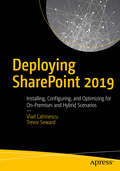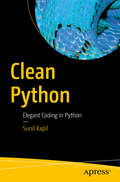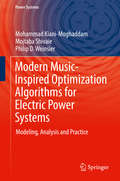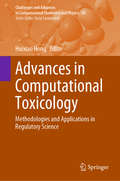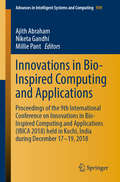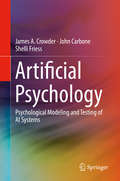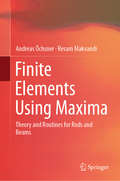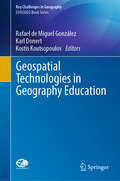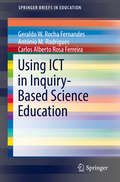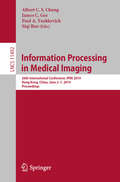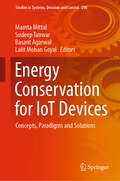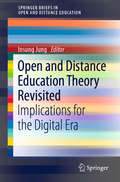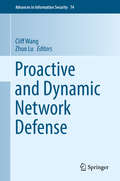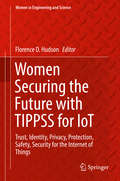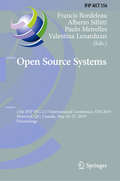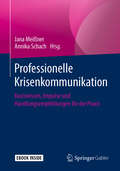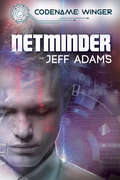- Table View
- List View
Game Theory, the Internet of Things and 5G Networks: Utilizing Game Theoretic Models to Characterize Challenging Scenarios (EAI/Springer Innovations in Communication and Computing)
by Josephina AntoniouThis book shows how to model selected communication scenarios using game theory. The book helps researchers specifically dealing with scenarios motivated by the increasing use of the Internet of Things (IoT) and 5G Communications by using game theory to approach the study of such challenging scenarios. The author explains how game theory acts as a mathematical tool that models decision making in terms of strategies and mechanisms that can result in optimal payoffs for a number of interacting entities, offering often antagonistic behaviors. The book explores new technologies in terms of design, development and management from a theoretical perspective, using game theory to analyze strategic situations and demonstrate profitable behaviors of the cooperative entities. The book identifies and explores several significant applications/uses/situations that arise from the vast deployment of the IoT. The presentation of the technological scenarios is followed in each of the first four chapters by a step-by-step theoretical model often followed by equilibrium proof, and numerical simulation results, that are explained in a tutorial-like manner. The four chapters tackle challenging IoT and 5G related issues, including: new security threats that IoT brings, e.g. botnets, ad hoc vehicular networks and the need for trust in vehicular communications, content repetition by offloading traffic onto mobile users, as well as issues due to new wearable devices that enable data collection to become more intrusive.
The Era of Internet of Things: Towards a Smart World
by Khaled Salah MohamedThis book introduces readers to all the necessary components and knowledge to start being a vital part of the IoT revolution. The author discusses how to create smart-IoT solutions to help solve a variety of real problems. Coverage includes the most important aspects of IoT architecture, the various applications of IoT, and the enabling technologies for IoT. This book presents key IoT concepts and abstractions, while showcasing real case studies. The discussion also includes an analysis of IoT strengths, weaknesses, opportunities and threats. Readers will benefit from the in-depth introduction to internet of things concepts, along with discussion of IoT algorithms and architectures tradeoffs. Case studies include smart homes, smart agriculture, and smart automotive.
Analysis of Doubly Truncated Data: An Introduction (SpringerBriefs in Statistics)
by Achim Dörre Takeshi EmuraThis book introduces readers to statistical methodologies used to analyze doubly truncated data. The first book exclusively dedicated to the topic, it provides likelihood-based methods, Bayesian methods, non-parametric methods, and linear regression methods. These procedures can be used to effectively analyze continuous data, especially survival data arising in biostatistics and economics. Because truncation is a phenomenon that is often encountered in non-experimental studies, the methods presented here can be applied to many branches of science. The book provides R codes for most of the statistical methods, to help readers analyze their data. Given its scope, the book is ideally suited as a textbook for students of statistics, mathematics, econometrics, and other fields.
Still Reigning: Thoughts of a Queen
by The Queen [of Twitter @queen_uk]“The Queen’s fake tweets perfectly sum up British humour . . . on a rather glorious spoof twitter account” (Culture Trip). She may not know firsthand the challenges of sitting atop the British throne for more than sixty years, but @Queen_UK has learned that ruling the Twitterverse is not for the faint of heart—or wit. Despite it all, she’s still in charge, still iconic, and still keeping the gin industry in business. Still reigning. In this uproarious collection of musings from a matriarch, the Queen [of Twitter] shares some unvarnished opinions about her subjects and the rest of the civilized world. Of her adoring public across the pond in America, she notes, “One thinks of them as a mother thinks of a teenage boy: with a mixture of pride and exasperation.” Witty and insightful, Still Reigning is a glimpse inside the mind of Britain’s pop monarch. Praise for The Queen [of Twitter]’s Gin O’Clock “Easily one of the funniest fictional Twitter accounts.” —Style & Then Some “It’s the sort of book to leave beside the loo, a jokey compilation you can dip in and out of—though I will be reading it from cover to cover, grinning from ear to ear because of its sharp, quick-witted and always apt sending-up of people with a public life.” —Foodepedia “Our favourite tweeter is publishing her diary. Here’s The Queen [of Twitter]’s guide to festive etiquette.” —Marie Claire “Witty and irreverent peeks at the innermost thoughts of the Royal Family.” —Choice
IUTAM Symposium on Solver-Coupling and Co-Simulation: Proceedings of the IUTAM Symposium on Solver-Coupling and Co-Simulation, Darmstadt, Germany, September 18-20, 2017 (IUTAM Bookseries #35)
by Bernhard SchweizerThis is the Proceedings of the IUTAM Symposium on Solver Coupling and Co-Simulation that was held in Darmstadt, Germany, September 18-20, 2017. The symposium focused on recent advances in the development of numerical methods for solver coupling, like new explicit, implicit and semi-implicit co-simulation methods, new approaches for realizing variable communication-time grids, and advances in the stability and convergence analysis of solver coupling methods.Recent developments in the practical application of co-simulation methods, for instance new fields of application for solver coupling approaches, new developments in the parallelization of dynamic models with co-simulation techniques, and standardization of co-simulation interfaces, i.e. standardization of data and model exchange were also discussed.The book brings together the research results of leading scientists in applied mathematics, mechanics, and engineering science, thus contributing to further develop numerical methods for coupled simulations.
Ubiquitous Computing and the Internet of Things: Prerequisites for the Development of ICT (Studies in Computational Intelligence #826)
by Elena G. PopkovaThis book gathers the outcomes of several scientific events that were organized and conducted by the Institute of Scientific Communications (Volgograd, Russia) and the leading universities of the Volgograd region. The contributing authors include more than 700 scholars from various cities and regions of Russia. 124 works were selected out of 3,000 papers on the preconditions of formation, transformation, and legal provision of social institutes, topics that are in high demand in connection with a core aspect of digital modernization – the Internet of Things. The book is intended for a broad target audience, including scholars of various generations and various disciplines. These include young researchers (undergraduates and postgraduates) and recognized scholars (professors and lecturers) who study the socio-economic and legal consequences of the emergence and dissemination of digital technologies, including the Internet of Things. In addition, the book will benefit all those who are interested in the development of the information society, information and telecommunication, and digital technologies. The content is divided into three logical parts, the first of which is devoted to the essence of the process of institutionalization and legal regulation of the information society. In the second part, the digital economy is analyzed in view of the spheres of the national economy. In the third, the authors study the peculiarities of state and corporate regulation, infrastructural provision and support for the security of entrepreneurship, which are currently developing on the basis of the Internet of Things.
Knowledge Graphs and Semantic Web: First Iberoamerican Conference, KGSWC 2019, Villa Clara, Cuba, June 23-30, 2019, Proceedings (Communications in Computer and Information Science #1029)
by Boris Villazón-Terrazas Yusniel Hidalgo-DelgadoThis book constitutes the thoroughly refereed proceedings of the First Iberoamerican Conference, KGSWC 2019, held in Villa Clara, Cuba, in June 2019. The 14 full papers and 1 short paper presented were carefully reviewed and selected from 33 submissions. The papers cover wide research fields including artificial intelligence; knowledge representation and reasoning; ontology engineering; natural language processing; description logics; information systems; query languages; world wide web; semantic web description languages; and information retrieval.
Frontier Computing: Theory, Technologies and Applications (FC 2018) (Lecture Notes in Electrical Engineering #542)
by Jason C. Hung Neil Y. Yen Lin HuiThis book presents the proceedings of the 6th International Conference on Frontier Computing, held in Kuala Lumpur, Malaysia on July 3–6, 2018, and provides comprehensive coverage of the latest advances and trends in information technology, science and engineering. It addresses a number of broad themes, including communication networks, business intelligence and knowledge management, web intelligence, and related fields that inspire the development of information technology. The contributions cover a wide range of topics: database and data mining, networking and communications, web and internet of things, embedded systems, soft computing, social network analysis, security and privacy, optical communication, and ubiquitous/pervasive computing. Many of the papers outline promising future research directions. The book is a valuable resource for students, researchers and professionals, and also offers a useful reference guide for newcomers to the field.
Deploying SharePoint 2019: Installing, Configuring, and Optimizing for On-Premises and Hybrid Scenarios
by Vlad Catrinescu Trevor SewardUpdate to a version of SharePoint that offers the best of both on-premise and the cloud using SharePoint 2019, the latest release of this cornerstone technology from Microsoft. Don your technical learning hat to get up close and confident on the new time-saving modern features of on-premise, and the many new security and hybrid settings.Deploying SharePoint 2019 begins with a general introduction to SharePoint 2019, covering new features and expanding your knowledge and capability with the technology systematically. You will learn about the new world of SharePoint, and how it was “cloud-born” from Office 365. From there you will dive into learning how to design a physical architecture for SharePoint Server 2019 and get familiar with the key concepts of high availability (HA) and disaster recovery (DR) solutions. What You'll Learn Install, configure, and optimize SharePoint 2019Understand SharePoint 2019 as a hybrid frameworkGet comfortable with new tools, such as Flow, PowerApps, and Power BIConfigure systems connected to SharePoint, such as Office Online Server and Workflow ManagerMigrate content and service databases from previous versions of SharePoint to SharePoint 2019Implement HA and DR topologies with SharePoint 2019 to satisfy business continuity requirements Who This Book Is For Those tasked with installing, configuring, and maintaining SharePoint Server 2019 for their organization. This book assumes some working knowledge of a previous release of SharePoint Server, such as SharePoint 2013 or SharePoint 2016.
Clean Python: Elegant Coding in Python
by Sunil KapilDiscover the right way to code in Python. This book provides the tips and techniques you need to produce cleaner, error-free, and eloquent Python projects. Your journey to better code starts with understanding the importance of formatting and documenting your code for maximum readability, utilizing built-in data structures and Python dictionary for improved maintainability, and working with modules and meta-classes to effectively organize your code. You will then dive deep into the new features of the Python language and learn how to effectively utilize them. Next, you will decode key concepts such as asynchronous programming, Python data types, type hinting, and path handling. Learn tips to debug and conduct unit and integration tests in your Python code to ensure your code is ready for production. The final leg of your learning journey equips you with essential tools for version management, managing live code, and intelligent code completion. After reading and using this book, you will be proficient in writing clean Python code and successfully apply these principles to your own Python projects. What You’ll Learn Use the right expressions and statements in your Python code Create and assess Python Dictionary Work with advanced data structures in Python Write better modules, classes, functions, and metaclassesStart writing asynchronous Python immediatelyDiscover new features in Python Who This Book Is ForReaders with a basic Python programming knowledge who want to improve their Python programming skills by learning right way to code in Python.
Modern Music-Inspired Optimization Algorithms for Electric Power Systems: Modeling, Analysis and Practice (Power Systems)
by Mohammad Kiani-Moghaddam Mojtaba Shivaie Philip D. WeinsierIn today’s world, with an increase in the breadth and scope of real-world engineering optimization problems as well as with the advent of big data, improving the performance and efficiency of algorithms for solving such problems has become an indispensable need for specialists and researchers. In contrast to conventional books in the field that employ traditional single-stage computational, single-dimensional, and single-homogeneous optimization algorithms, this book addresses multiple newfound architectures for meta-heuristic music-inspired optimization algorithms. These proposed algorithms, with multi-stage computational, multi-dimensional, and multi-inhomogeneous structures, bring about a new direction in the architecture of meta-heuristic algorithms for solving complicated, real-world, large-scale, non-convex, non-smooth engineering optimization problems having a non-linear, mixed-integer nature with big data. The architectures of these new algorithms may also be appropriate for finding an optimal solution or a Pareto-optimal solution set with higher accuracy and speed in comparison to other optimization algorithms, when feasible regions of the solution space and/or dimensions of the optimization problem increase. This book, unlike conventional books on power systems problems that only consider simple and impractical models, deals with complicated, techno-economic, real-world, large-scale models of power systems operation and planning. Innovative applicable ideas in these models make this book a precious resource for specialists and researchers with a background in power systems operation and planning.Provides an understanding of the optimization problems and algorithms, particularly meta-heuristic optimization algorithms, found in fields such as engineering, economics, management, and operations research;Enhances existing architectures and develops innovative architectures for meta-heuristic music-inspired optimization algorithms in order to deal with complicated, real-world, large-scale, non-convex, non-smooth engineering optimization problems having a non-linear, mixed-integer nature with big data;Addresses innovative multi-level, techno-economic, real-world, large-scale, computational-logical frameworks for power systems operation and planning, and illustrates practical training on implementation of the frameworks using the meta-heuristic music-inspired optimization algorithms.
Advances in Computational Toxicology: Methodologies and Applications in Regulatory Science (Challenges and Advances in Computational Chemistry and Physics #30)
by Huixiao HongThis book provides a comprehensive review of both traditional and cutting-edge methodologies that are currently used in computational toxicology and specifically features its application in regulatory decision making. The authors from various government agencies such as FDA, NCATS and NIEHS industry, and academic institutes share their real-world experience and discuss most current practices in computational toxicology and potential applications in regulatory science. Among the topics covered are molecular modeling and molecular dynamics simulations, machine learning methods for toxicity analysis, network-based approaches for the assessment of drug toxicity and toxicogenomic analyses. Offering a valuable reference guide to computational toxicology and potential applications in regulatory science, this book will appeal to chemists, toxicologists, drug discovery and development researchers as well as to regulatory scientists, government reviewers and graduate students interested in this field.
Innovations in Bio-Inspired Computing and Applications: Proceedings of the 9th International Conference on Innovations in Bio-Inspired Computing and Applications (IBICA 2018) held in Kochi, India during December 17-19, 2018 (Advances in Intelligent Systems and Computing #939)
by Ajith Abraham Niketa Gandhi Millie PantThis book highlights recent research on bio-inspired computing and its various innovative applications in Information and Communication Technologies. It presents 50 high-quality papers from the 9th International Conference on Innovations in Bio-Inspired Computing and Applications (IBICA 2018) and 7th World Congress on Information and Communication Technologies (WICT 2018), which was held at Toc H Institute of Science and Technology (TIST) on December 17–19, 2018. IBICA-WICT 2018 was a premier conference and brought together researchers, engineers and practitioners whose work involved bio-inspired computing, computational intelligence and their applications in information security, real-world contexts etc. Including contributions by authors from 22 countries, the book offers a valuable reference guide for all researchers, students and practitioners in the fields of Computer Science and Engineering.
Artificial Psychology: Psychological Modeling and Testing of AI Systems
by James A. Crowder John Carbone Shelli FriessThis book explores the subject of artificial psychology and how the field must adapt human neuro-psychological testing techniques to provide adequate cognitive testing of advanced artificial intelligence systems. It shows how classical testing methods will reveal nothing about the cognitive nature of the systems and whether they are learning, reasoning, and evolving correctly; for these systems, the authors outline how testing techniques similar to/adapted from human psychological testing must be adopted, particularly in understanding how the system reacts to failure or relearning something it has learned incorrectly or inferred incorrectly. The authors provide insights into future architectures/capabilities that artificial cognitive systems will possess and how we can evaluate how well they are functioning. It discusses at length the notion of human/AI communication and collaboration and explores such topics as knowledge development, knowledge modeling and ambiguity management, artificial cognition and self-evolution of learning, artificial brain components and cognitive architecture, and artificial psychological modeling.Explores the concepts of Artificial Psychology and Artificial Neuroscience as applied to advanced artificially cognitive systems;Provides insight into the world of cognitive architectures and biologically-based computing designs which will mimic human brain functionality in artificial intelligent systems of the future;Provides description and design of artificial psychological modeling to provide insight into how advanced artificial intelligent systems are learning and evolving;Explores artificial reasoning and inference architectures and the types of modeling and testing that will be required to "trust" an autonomous artificial intelligent systems.
Finite Elements Using Maxima: Theory and Routines for Rods and Beams
by Andreas Öchsner Resam MakvandiThis book provides a study aid on the finite element method. Based on the free computer algebra system “Maxima”, it presents routines to symbolically or numerically solve problems in the context of plane truss and frame structures. This allows readers to not only check classical “hand calculations” but also understand the computer implementation of the method. The mechanical theories focus on the classical one-dimensional structural elements, i.e. bars, Euler–Bernoulli and Timoshenko beams as well as their combination to generalized beam elements. Focusing on one-dimensional elements reduces the complexity of the mathematical framework and the resulting matrix equations can still be displayed with all components, and not only in a symbolic representation. The use of a computer algebra system and the incorporated functions, e.g. for equation solving, highlights the methodology of the finite element method rather than standard procedures.The book is based on the Springer Brief “Finite Elements for Truss and Frame Structures” (978-3-319-94940-6) by the same authors.
Geospatial Technologies in Geography Education (Key Challenges in Geography)
by Rafael de Miguel González Karl Donert Kostis KoutsopoulosThis book addresses new pedagogies focusing on the use of geospatial technologies and geomedia in the classroom. Today, geospatial technologies are substantially influencing geography teaching and learning, particularly in secondary education. Web-GIS, virtual globes, storytelling, maps and apps for mobile devices are transforming the nature and design of geography curricula, instructional processes, didactics, resources and assessments. Undoubtedly, geography is among those school subjects that have benefited most from the implementation of new technologies in the classroom. Geospatial technologies can be used to develop inquiry-based learning or project-based learning pedagogies and help students to acquire spatial reasoning and spatial citizenship skills in the context of education for sustainable development.This book highlights a range of initiatives, projects and educational practices – from several European countries and settings – related to geospatial challenges in geography education. Given its scope, it will be equally appealing to scientists, students and teachers of geography and other fields using geospatial technologies and geomedia.
Using ICT in Inquiry-Based Science Education (SpringerBriefs in Education)
by Geraldo W. Rocha Fernandes Carlos Alberto Rosa Ferreira António M. RodriguesThis book analyzes the main Information and Communication Technologies (ICT) used in science education and the main theoretical approaches that support science education mediated by ICT in order to show how digital technologies can be employed in Inquiry-Based Science Education. It presents the results of a comprehensive review of studies focusing both on the use and effects of digital technologies in science education and on the different theoretical approaches that support the use of ICTs in science teaching.By doing so, the book provides a useful summary of the current research in the field and a strong analysis of its limitations. It concludes that there are few studies that report strategies and didactics for the practical use of ICT in science classes and that the use of ICT in science education can’t be seen as an isolated action without a theoretical basis to support it. Based on these conclusions, the volume identifies the main ICTs used in inquiry activities, the main steps in inquiry activities used in science education and their approaches to the use of ICT. It shows that the use of ICT in Inquiry-Based Science Education allows students to develop more active work styles, improved attitudes towards science, better conceptual and theoretical understanding, improved reasoning, better modelling capabilities, and improved teamwork, along with improvements in other abilities. Using ICT in Inquiry-Based Science Education will be a valuable resource for science teachers and science teacher educators looking for an introductory text that presents an overview of the scientific research analyzing the implementation of digital technologies in science teaching and that provides useful insights to all educators interested in using digital technologies to introduce their students in the world of scientific inquiry and research.
Information Processing in Medical Imaging: 26th International Conference, IPMI 2019, Hong Kong, China, June 2–7, 2019, Proceedings (Lecture Notes in Computer Science #11492)
by Albert C. Chung James C. Gee Paul A. Yushkevich Siqi BaoThis book constitutes the proceedings of the 26th International Conference on Information Processing in Medical Imaging, IPMI 2019, held at the Hong Kong University of Science and Technology, Hong Kong, China, in June 2019. The 69 full papers presented in this volume were carefully reviewed and selected from 229 submissions. They were organized in topical sections on deep learning and segmentation; classification and inference; reconstruction; disease modeling; shape, registration; learning motion; functional imaging; and white matter imaging. The book also includes a number of post papers.
Energy Conservation for IoT Devices: Concepts, Paradigms and Solutions (Studies in Systems, Decision and Control #206)
by Mamta Mittal Sudeep Tanwar Basant Agarwal Lalit Mohan GoyalThis book addresses the Internet of Things (IoT), an essential topic in the technology industry, policy, and engineering circles, and one that has become headline news in both the specialty press and the popular media. The book focuses on energy efficiency concerns in IoT and the requirements related to Industry 4.0. It is the first-ever “how-to” guide on frequently overlooked practical, methodological, and moral questions in any nations’ journey to reducing energy consumption in IoT devices. The book discusses several examples of energy-efficient IoT, ranging from simple devices like indoor temperature sensors, to more complex sensors (e.g. electrical power measuring devices), actuators (e.g. HVAC room controllers, motors) and devices (e.g. industrial circuit-breakers, PLC for home, building or industrial automation). It provides a detailed approach to conserving energy in IoT devices, and comparative case studies on performance evaluation metrics, state-of-the-art approaches, and IoT legislation.
Open and Distance Education Theory Revisited: Implications for the Digital Era (SpringerBriefs in Education)
by Insung JungThis book explores foundational theories that have been applied in open and distance education (ODE) research and refined to reflect advances in research and practice. In addition, it develops new theories emerging from recent developments in ODE. The book provides a unique and up-to-date source of information for ODE scholars and graduate students, enabling them to make sense of essential theory, research and practice in their field, and to comprehend the gaps in, and need for further enquiry into, theoretical approaches in the digital era. It also offers theory-based advice and guidelines for practitioners, helping them make and justify decisions and actions concerning the development, implementation, research and evaluation of ODE.
Proactive and Dynamic Network Defense (Advances in Information Security #74)
by Cliff Wang Zhuo LuThis book discusses and summarizes current research issues, identifies challenges, and outlines future directions for proactive and dynamic network defense. This book also presents the latest fundamental research results toward understanding proactive and dynamic network defense by top researchers in related areas. It includes research results that offer formal frameworks to define proactive and dynamic network defense, and develop novel models to analyze and evaluate proactive designs and strategies in computer systems, network systems, cyber-physical systems and wireless networks. A wide variety of scientific techniques have been highlighted to study these problems in the fundamental domain. As the convergence of our physical and digital worlds grows fast pace, protecting information systems from being tampered or unauthorized access is becoming one of the most importance issues. The traditional mechanisms of network defense are built upon a static, passive, and reactive nature, which has insufficient to defend against today's attackers that attempt to persistently analyze, probe, circumvent or fool such mechanisms. It has not yet been fully investigated to address the early stage of “cyber kill chain” when adversaries carry out sophisticated reconnaissance to plan attacks against a defense system. Recently, proactive and dynamic network defense has been proposed as an important alternative towards comprehensive network defense. Two representative types of such defense are moving target defense (MTD) and deception-based techniques. These emerging approaches show great promise to proactively disrupt the cyber-attack kill chain and are increasingly gaining interest within both academia and industry. However, these approaches are still in their preliminary design stage. Despite the promising potential, there are research issues yet to be solved regarding the effectiveness, efficiency, costs and usability of such approaches. In addition, it is also necessary to identify future research directions and challenges, which is an essential step towards fully embracing proactive and dynamic network defense. This book will serve as a great introduction for advanced-level computer science and engineering students who would like to start R&D efforts in the field of proactive and dynamic network defense. Researchers and professionals who work in this related field will also find this book useful as a reference.
Women Securing the Future with TIPPSS for IoT: Trust, Identity, Privacy, Protection, Safety, Security for the Internet of Things (Women in Engineering and Science)
by Florence D. HudsonThis book provides insight and expert advice on the challenges of Trust, Identity, Privacy, Protection, Safety and Security (TIPPSS) for the growing Internet of Things (IoT) in our connected world. Contributors cover physical, legal, financial and reputational risk in connected products and services for citizens and institutions including industry, academia, scientific research, healthcare and smart cities. As an important part of the Women in Science and Engineering book series, the work highlights the contribution of women leaders in TIPPSS for IoT, inspiring women and men, girls and boys to enter and apply themselves to secure our future in an increasingly connected world. The book features contributions from prominent female engineers, scientists, business and technology leaders, policy and legal experts in IoT from academia, industry and government.Provides insight into women’s contributions to the field of Trust, Identity, Privacy, Protection, Safety and Security (TIPPSS) for IoTPresents information from academia, research, government and industry into advances, applications, and threats to the growing field of cybersecurity and IoTIncludes topics such as hacking of IoT devices and systems including healthcare devices, identity and access management, the issues of privacy and your civil rights, and more
Open Source Systems: 15th IFIP WG 2.13 International Conference, OSS 2019, Montreal, QC, Canada, May 26–27, 2019, Proceedings (IFIP Advances in Information and Communication Technology #556)
by Francis Bordeleau Alberto Sillitti Paulo Meirelles Valentina LenarduzziThis open access book constitutes the refereed proceedings of the 15th IFIP WG 2.13 International Conference on Open Source Systems, OSS 2019, held in Montreal, Quebec, Canada, in May 2019.The 10 revised full papers and 5 short papers presented were carefully reviewed and selected from 35 submissions. The papers cover a wide range of topics in the field of free/libre open source software (FLOSS) and are organized in the following thematic sections: mining OSS data; organizational aspects of FLOSS projects; FLOSS adoption; FLOSS cost and licenses; and FLOSS education and training.
Professionelle Krisenkommunikation: Basiswissen, Impulse und Handlungsempfehlungen für die Praxis
by Jana Meißner Annika SchachNutzen Sie dieses Buch als Grundlage für Ihre KrisenkommunikationSie möchten die Krisenkommunikation in Ihrem Unternehmen verbessert? Dieses Werk gibt Praktikern zahlreiche Tipps, wie sie mit problematischen Situationen umgehen können.Lernen Sie, wie Sie Unternehmenskrisen bewältigen. Doch nicht nur das, auch das Risikomanagement und die Krisenprävention spielt eine wichtige Rolle. Darüber hinaus vermittelt dieses Buch verschiedene wissenschaftliche Erkenntnisse aus dem Bereich der Krisenkommunikation.Die Herausgeber richten sich unter anderem an:• Unternehmer und Führungskräfte• Risiko- und Krisenmanager• KommunikatorenUm praktisches Fachwissen zu vermitteln, vereinen die Herausgeber die Beiträge verschiedener Experten aus Wissenschaft und Praxis. Unter anderem geht es dabei und das Business Continuity Management, interne Kontrollsystem und organisationale Resilienz. Darüber hinaus findet der Leser zahlreiche Handlungsempfehlungen für Krisenkommunikatoren.
Netminder (Codename: Winger #4)
by Jeff AdamsCodename: Winger: Book FourFor teenage secret agent Theo Reese, summer brought one surprise after another, and now that he’s back at school, the shocks keep coming. The unthinkable has happened—enemies have breached Tactical Operational Support, forcing Theo and his parents to instigate the protocols they’ve put in place in case of a worst-case scenario. As Theo goes on the run and tries to stay ahead of those pursuing them, he realizes the TOS network is down… and he’s on his own.He soon discovers the renegade organization Blackbird is responsible. Theo's been targeted by an old nemesis, who will do whatever it takes to force his hand and obtain his help in taking global control of the internet. Theo must prevent the internet hijacking, and while he finds allies, they’re in the last place he expects….
